PERIKLES (c. 490–429 BC) Ancient Greek politician, strategist...

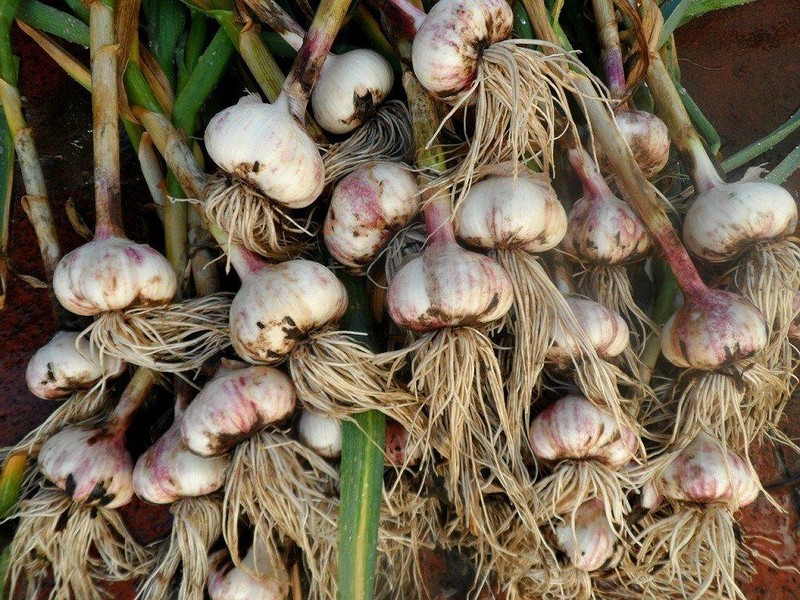
Harvesting summer and winter garlic takes place at different times. However, there are no exact ones, since the ripening time of the product largely depends on weather conditions.
======================================================
When to Harvest Winter Garlic
Harvesting of winter garlic usually occurs at the end of July. Early-ripening varieties are ready for digging 85-95 days after germination, and late-ripening - after 100-110 days. Even if you do not know which variety you are cultivating in your garden, appearance plants will understand that it is time to harvest the garlic. In mature plants, the leaves turn yellow, the film on the inflorescences cracks. Once this happens, summer garlic harvesting should be done within 5-7 days.
In addition, the timing of harvesting depends on the planting material, in particular on the garlic fractions. Single-tooth young heads ripen 25 days earlier than the earliest varieties of winter garlic. Then plants ripen that were grown from small teeth, and a week later - from medium and large ones. 
If the garlic is overripe, the scales covering the heads will crack, the cloves will crumble and will not store well.
You also need to know that digging garlic is best in the morning or evening. During the day, the hot sun can dry out the heads and deprive the teeth of juiciness.
When to harvest spring garlic
Spring garlic is planted in the spring, which is why it is harvested later than winter garlic. Usually the time of digging up the heads falls on the second half of August - mid-September. At this time, new leaves cease to appear on the plant, the old ones turn yellow, the neck softens, the stem lies down.
The term for harvesting spring garlic is also not to be missed. Autumn rains can lead to the growth of young roots. Then the heads will be poorly stored and become less useful.
The main plus of winter garlic is larger cloves, which are more convenient to add to food. However, spring garlic is stored longer than winter garlic. 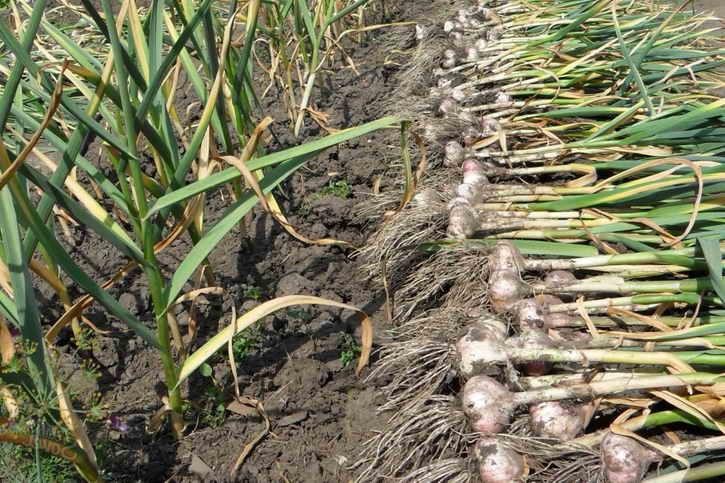
Spring garlic is also harvested in dry and sunny weather.
When harvesting spring and winter garlic, it is important not to damage the tender heads, since even small dents can become a source of infection. Garlic after harvesting is dried in a fairly warm room under a canopy or in special dryers with ventilation. When the heads dry well, the tops are cut off from them, leaving a stump (about 5 cm long) and roots (up to 2 cm long).
10 ways to store garlic at home
It is important to know not only how to properly remove plants from the garden, but also how to store garlic at home. Sometimes this is not easy to do. After all, in winter, the heads often rot or dry out, and in the spring they begin to germinate. To prevent this from happening, summer residents create special favorable conditions for storing garlic in an apartment.
1. Storing garlic in a glass jar
To remove the infection, the bottom of the head, along with the remnants of the roots, is gently burned (this can be done over the flame of a candle or gas stove). Then the garlic is placed in a glass jar with an open neck and stored in a kitchen cabinet for 2-3 months.
2. Storage of garlic in flour
A small layer of flour is poured into a glass jar with a volume of 3 liters. Heads with a burnt bottom are placed there in a row. Then a layer of flour is poured on them and garlic is laid on top again. Thus, the jar is filled to the brim, but at the very top there should be a layer of flour.
3. Storage of garlic in paraffin
Water is poured into a small saucepan, put on the stove, brought to a boil, then the minimum temperature is set (the water should not boil). Paraffin is cut into pieces, placed in a smaller container and placed in a pot of hot water. When the paraffin is melted, the garlic is taken by the tip of the stem, lowered there for 1-2 seconds, and then placed in a dry box. 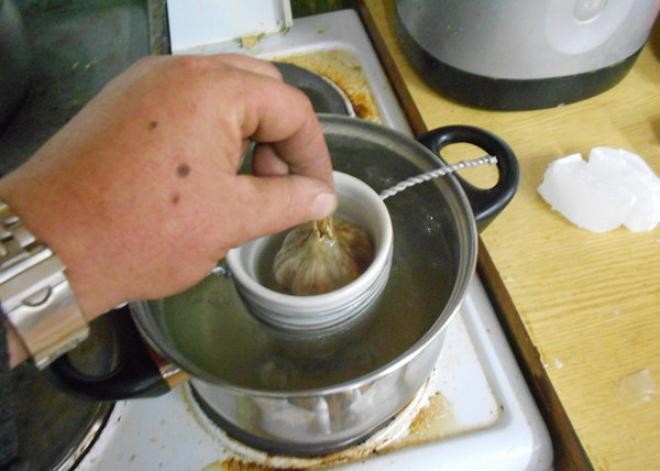
Garlic cannot be kept in paraffin for a long time, otherwise it will just boil.
4. Storage of garlic in vegetable oil
The garlic is thoroughly washed, dried on a towel, and then placed in a jar of vegetable oil.
5. Storing garlic in cling film and sawdust
Each head is wrapped with a film (preferably in 2 layers) so that only the bottom with roots remains open. Garlic is placed in a cardboard box, covered with sawdust and stored in a dry place at room temperature.
6. Storing Garlic in Salt
Garlic is placed in a plastic or glass box, sprinkling each layer with salt. The container is placed in a cellar with a temperature of 3-5 ° C.
7. Storing garlic in a net
Garlic is woven into a braid or placed in a net (it can be replaced with nylon tights) and hung in a dry and cool room. 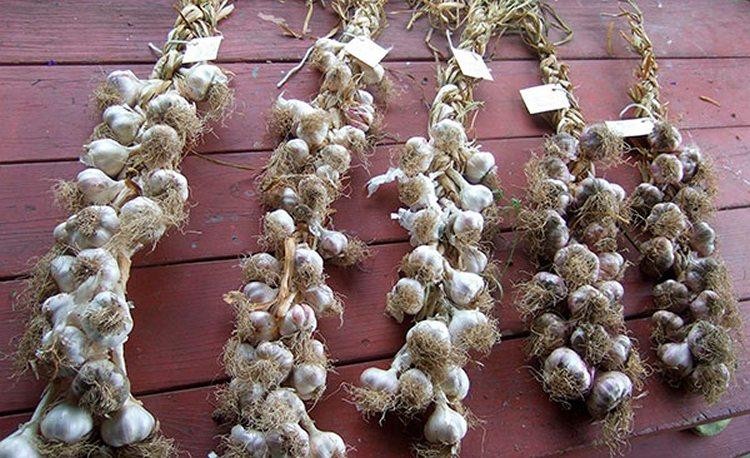
If you are going to braid garlic, do not cut dry stems.
8. Storing garlic in a cloth bag
Garlic is placed in a bag of dense fabric, tied and hung between wooden window frames.
9. Storage of garlic in cloth and polyethylene
Garlic is placed in a linen bag, as in the previous method, a plastic bag is put on top (it is not tied) and left in the room or in the kitchen. Air the bag once a week.
10. Storing garlic in the ground
The garlic is thoroughly dried, placed in a plastic bag, tightly tied and placed in the ground to a depth of 35-40 cm in an area where there is no surface groundwater. The package is sprinkled with sawdust and buried with soil. In this place, garlic is stored until spring and dug out when the ground thaws.
Garlic has long been an essential ingredient in many dishes and folk recipes. In order to have fragrant and fresh heads on hand all year round, you need to know how and where to properly store them at home in the winter.
There are several common ways to store this vegetable that will keep it fit for consumption until the next harvest.
As a rule, the following places are chosen for this:
It is more convenient for owners of private houses to choose a subfloor, since there may not always be enough space in the refrigerator. Having a dry place in an apartment or house is perfect for placing garlic braids and bunches or hanging a net. A glazed balcony is a great place to "winter" this vegetable in jars and boxes.
The time-tested method it is a plaited braid of heads dried with a stalk. The finished braid is left in a dark and dry room. For this, a closet or pantry is suitable. Garlic braids take up very little space, but require skill and skill to weave the stems together well.
Dried heads with stems are tied into a bundle with a rope and hung in a dry room. The method is practically no different from the previous one, and the beams can also act as interior decoration.
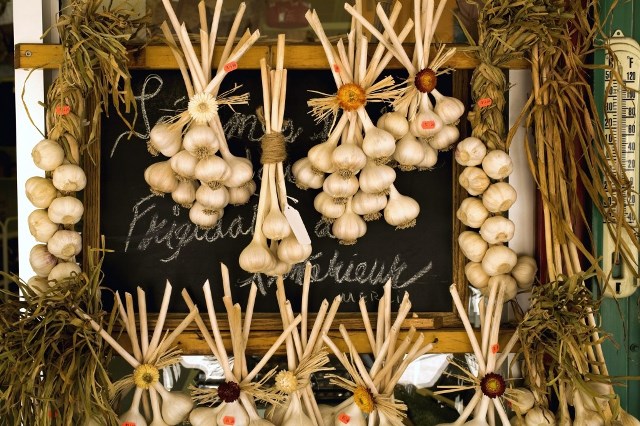
Many people choose three-liter jars for overwintering vegetables without filling their heads with anything. This allows it not to dry out and germinate. Banks must be placed in the refrigerator or on the balcony.
To keep the garlic in the box, it is necessary to sprinkle its bottom with salt, then lay out some of the heads, sprinkle with salt again and lay out layer by layer in this way. This option allows the vegetable to remain fresh and juicy for a long time.
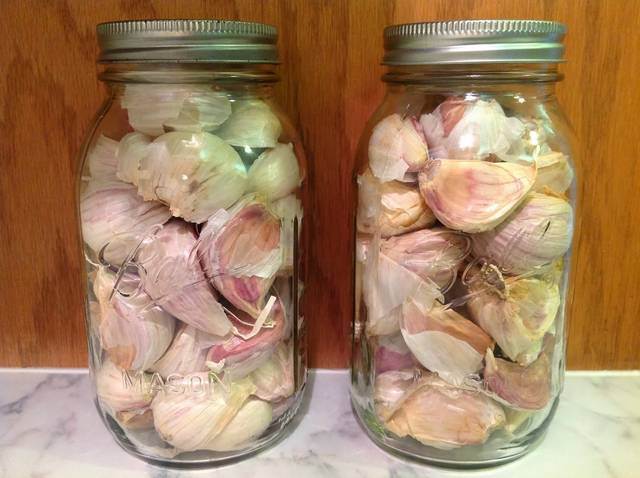
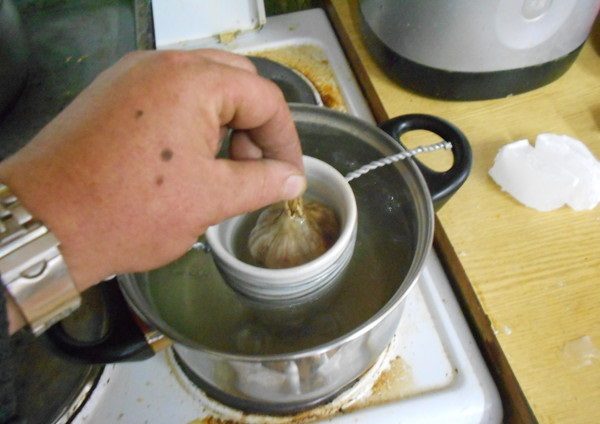
For this, bags made from natural materials are used. R It is recommended to periodically sort out the contents of the bag to remove damaged heads.
To reduce the risk of mold and bacteria, soak the garlic in a concentrated saline solution, let it dry, and then place it in a bag.
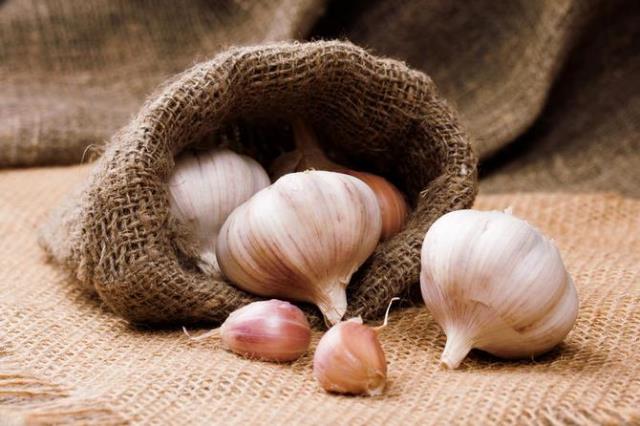
To leave a vegetable for the winter in the refrigerator, it dry well, put into paper bags and put separately from other products.
To prevent spoilage of the product in the refrigerator, it is recommended to sprinkle the contents of the bags with salt or onion peel.
You can freeze both whole peeled cloves wrapped in foil or cling film, or finely chopped to reduce cooking time when using them. This option is suitable for those who use the vegetable in cooking less often, since freezing changes the taste and structure of this product.
For preservation, you can use wine or vinegar. To do this, peeled cloves are placed in a jar and poured with dry wine or white vinegar. A tightly closed jar is placed in the refrigerator. The method allows the garlic not to deteriorate for up to four months.
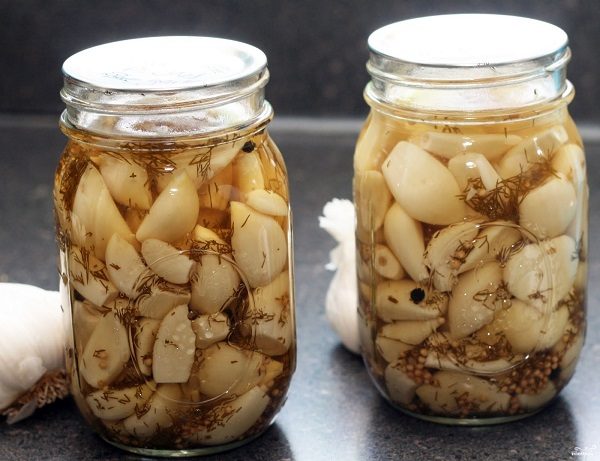
Properly carried out preparation is a guarantee that the product will not deteriorate in winter period in a city apartment.
Preparation for wintering should begin with the harvesting stage. It is important to know that there are two types of garlic that determine the timing of its collection:
Digging must be done carefully, since damaged heads deteriorate much faster than whole ones and are more susceptible to the development of bacteria. For this purpose, a pitchfork or a shovel is used.
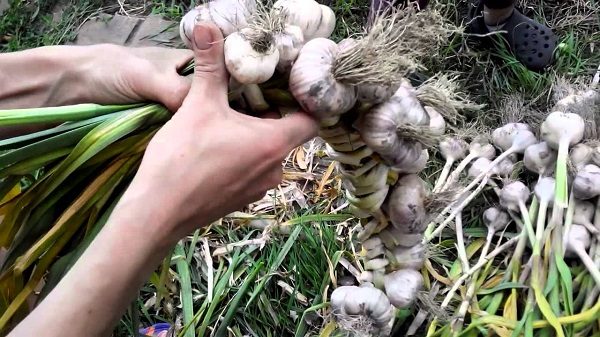 Preparing garlic for storage - tying together
Preparing garlic for storage - tying together After digging the garlic, dry it well. Do it better in the open sun. The stems must be cut off, except in cases where weaving braids or bundles is supposed.
After harvesting, you need to get rid of all:
Unsuitable garlic can be dried and used as a condiment.
After carrying out all of the above manipulations, you can begin to send the vegetable for the winter.
The most important and practically the only problem that can occur during wintering is damage to the heads. It can happen for several reasons.
First of all, it is a fungal infection. This can be avoided by very careful sorting. Also, the product may deteriorate due to improper storage conditions.
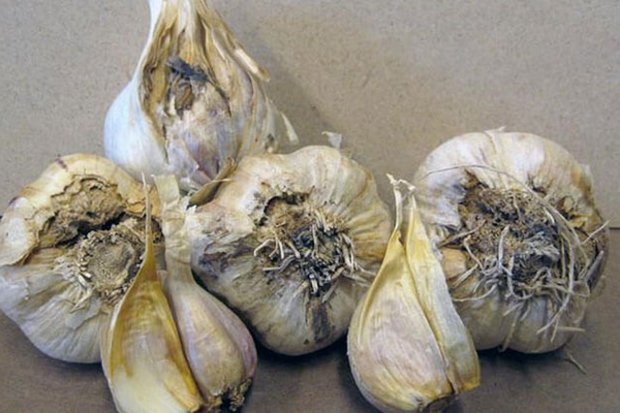
The following signs allow you to determine the corruption:
In order for garlic to remain usable in the winter season as long as possible, it is necessary to strictly observe the algorithm for preparing for wintering and the conditions of the method chosen for this purpose.
Preserving garlic for the winter at home is quite simple. The main thing is to follow all the preparation measures and choose the most suitable method for yourself. Having followed all the established recommendations, you will be able to delight yourself with a tasty and juicy vegetable until the harvest of a new crop.
First of all, you need to know that there are two types of garlic, the timing of harvesting and the degree of preservation of which are somewhat different. These species are commonly known by the people under the name:
Spring garlic usually has better keeping quality and does not spoil for a longer time. But with the right choice of storage method, winter garlic can also be stored for several months.
When the garlic harvest is finished, the vegetable must be dried well. In warm climates and dry weather, this can be done right in the garden, leaving the bulbs to lie on it for five days. If natural conditions do not allow this, then garlic can be spread out on the terrace under a canopy or in the attic. Then the plant must be cut off the roots and cut the stem, leaving about 2 centimeters. If this is not done, then the garlic will quickly deteriorate. An exception is the option when braiding will be the future storage method. In this case, the “tails” of the garlic are not cut off.
Before you start implementing any of the ways to store garlic, you need to sort it out. After sorting, it is necessary to leave dense, not divided into teeth, heads with a whole surface, without scratches, cuts and dents, not affected by any disease. Damaged but healthy garlic can be set aside for drying or freezing.
Then you need to determine for yourself where and how to store garlic. The best way is to save it:
Garlic is an unpretentious plant in storage. It can remain almost unchanged (depending on the variety) at temperatures from +20 to +2 degrees Celsius. The main condition for this is the presence of a dry room with a relatively cool temperature. It is impossible to allow both too high a percentage of moisture in it (this leads to rotting of the product), and its minimum indicators (which contributes to the drying of the bulbs).
The best temperature for storing winter garlic is to reach a thermometer of +2 - +4 degrees. Due to the smaller number of covering scales, it is stored worse and more often exposed to diseases. Its summer counterpart is much more enduring and retains its qualities even at +16 - +20 degrees.
Before you put a vegetable in the selected container, you must try to protect it from two main problems: drying out and germination. First, each bulb is slightly scorched over the fire from below - this prevents the likelihood of its germination. Then the wax or paraffin is melted and, carefully, so as not to dry out, one by one, garlic heads are dipped there. Pre-wax cools slightly, because if it is very hot, then the protective layer of garlic will become thinner.
The wax layer on the surface of the bulbs delays the evaporation of moisture. At the same time, the plant continues to breathe, as a result of which carbon dioxide accumulates in it, which leads to the death of pathogens.
If there is a threat of disease or moldiness of the vegetable, the following method is used. Taking vegetable oil, calcinate it on fire for two hours. Then add iodine at the rate of ten drops per half liter. After that, the bulbs are lowered there and dried in the sun.
The oldest and most famous way to preserve garlic is to weave beautiful braids from it. With this method, garlic with uncircumcised stems is used, and the weaving of the pigtail starts from its lower part. Gradually, a rope is woven into the braid, which makes the product able to maintain its shape for a long time. How to do this specifically can be found on the Internet in many videos.
Braided garlands are usually hung on carnations, using a specially made loop at the top. A useful decoration gives a kind of rustic flavor to the whole room and, at the same time, disinfects it very well.
The second "grandmother's" way of storing a plant in weight is to fill it with old stockings, which are suspended according to the principle of braids. Instead of stockings, it is possible to use a grid with a small cell. With the first two methods described, garlic, as a rule, never rots. If the heads dry out or sprout, this is very quickly detected visually or with the help of palpation. Such bulbs are usually removed easily and painlessly for the rest.
These methods are well suited when the task is to save a large crop of the product. They are characterized by pouring layers of garlic with some kind of filler:
For the first method, cardboard or plywood boxes are taken, in which there are slots or specially made small holes for air circulation. Two or three centimeters of salt are poured down, and a layer of garlic bulbs is laid on top. Then salt is poured again, and after it a layer of garlic. Thus, the entire box is filled. A prerequisite is the presence of a layer of salt on top, which must also be at least two centimeters. In addition, it is necessary to pour salt between the bulbs, in no case allowing them to come into contact with each other.
The methods of storing the product in ash or sawdust are almost identical to the first. A two-centimeter layer of ash or sawdust is poured onto the bottom of the box (coniferous ones are especially recommended), then garlic is placed and the entire container is filled by alternating layers. Here it is also necessary that the top layer consists of a filler.
When storing garlic in the husk at home, both boxes and boxes, as well as linen bags, and wicker baskets are used as containers. Bulbs in such a natural filler do not lose their qualities for a long time.
Another way to keep garlic healthy for as long as possible is to layer it in jars and top with flour. You need to start by first pouring a layer of flour two or more centimeters thick, then put the garlic, cover it with flour and so on until the last layer, which must necessarily consist of flour.
If you are not faced with the task of preserving a large batch of garlic products, then it is quite possible to save this product during the autumn-winter season in an apartment. You can do this with or without a refrigerator. In this case, the main methods will be the following:
Freezing garlic is usually used in the following cases:
Types of freezing garlic:
Garlic is popular vegetable crop, which has a characteristic pungent taste and a peculiar smell. It is used for cooking various dishes and for fresh food. Those who have their own garden grow the plants themselves. If you're a beginner gardener, learn how to properly harvest and store your garlic crop at home so you can stock up all year round.
There are two types of garlic - spring and winter. For varieties belonging to the first type, the following features are characteristic:
Spring garlic does not germinate for a long time, as it has a long dormant period. This is genetically incorporated, which makes it possible to easily store garlic in an apartment, not to mention the wide possibilities for this in a private house.
Winter varieties of garlic are different. Winter garlic is characterized by:
Winter varieties are quite capricious in storage. Autumn planting dates suggest early germination of teeth. It all depends on the variety though.
There is an opinion that spring garlic is better than winter garlic. Yes, the bulk of spring varieties lie for 10 months (there is not a single such variety among winter crops), but, for example, a spring variety:
However, there are also winter varieties with very good keeping quality:
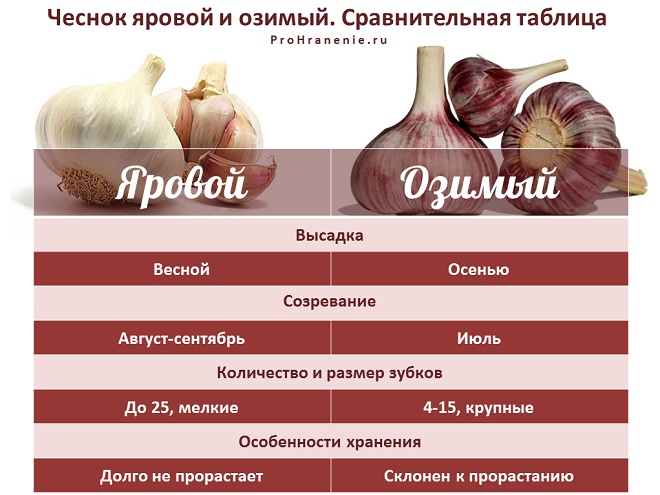
Comparison of some characteristics of spring and winter garlic
If we talk about which garlic is better, then there is no single correct answer to this question. Each type of plant has its own advantages and disadvantages.
However, belonging to a certain variety does not guarantee that the storage of garlic at home will be 100% successful. To do this, it is necessary to properly harvest the resulting crop, prepare it, and create optimal conditions for saving the vegetable.
Do you know that…
There is no zoning for garlic. All varieties of the register of breeding achievements are suitable for all regions.
In order for the storage of garlic not to cause difficulties in the winter months, it must be properly harvested from the garden.
For winter varieties, this time comes in the month of July. The approximate date can be called the 12th, but it all depends on the region, climatic conditions, cultivation technology:
How to determine the readiness of garlic for harvest if you are going to store it for the winter? It is very easy to do this. In winter varieties, by this time the lower leaves turn yellow and dry out, the head is fully formed, the integumentary shirt has become dry, strong and matte. It is this condition of the bulbs that indicates that it is time to dig out the garlic.
Tip of the day
In order not to be mistaken, leave a couple of arrows. And as soon as the integumentary scales burst on the bulbs, the garlic is ready for harvesting.
Spring garlic is kept in the ground longer. It ripens from late July to early September. The signal for harvesting is the complete lodging and drying of the tops.
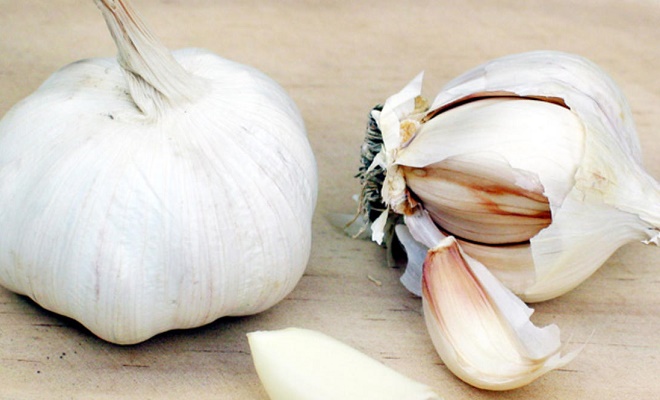
In fully mature heads, the lobules are easily separated from each other, and the integumentary scales are easily peeled off.
Tip of the day
Avoid cracking the scales on the heads. This will negatively affect the storage results. If necessary, it is better to remove the garlic earlier, it “ripens” by winter.
Many experienced gardeners know that storing garlic begins with proper harvesting:
Tip of the day
Do not dig up garlic in rainy weather. Raw heads are more likely to deteriorate and not last until spring.
There are two options for storing garlic at home: cold and warm. Regardless of the method, vegetables intended for laying in the winter should create the right conditions.
To store garlic, the following temperature and humidity are required:
It is also required to cover stocks from light, because it provokes the germination of teeth. This is especially important for winter varieties, although spring varieties also do not hurt.
Do you know that…
Some advisers recommend cauterizing or removing the rootlobe to prevent the garlic from sprouting. Pointless occupation. If this is a feature of the variety, with or without roots, the vegetable will still germinate. But if you damage the head too much, then it will probably rot.
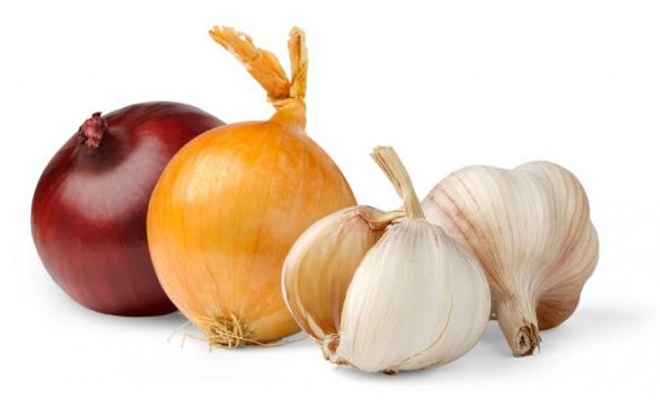
Of all vegetables and fruits, only onion is suitable for storage with garlic. He needs the same conditions and does not harm the sharp smell of the "neighbor"
Now about how to properly store garlic in the winter if you live in your home.
Those who decide how to store garlic in a city apartment have much fewer options. There are only three places for this. At your disposal will be:
The conditions there are not the best, but quite acceptable.
Do you know that…
With insufficient moisture, garlic dries, with excess it rots, and at elevated temperature and light, it begins to sprout.
In a private house or apartment, there is also a good opportunity to keep garlic in the refrigerator. Since there is not so much space in it, it is better to store non-standard in it. Those bulbs that have stood on the vine and cracked are the least under normal conditions, but in the refrigerator they are able to remain fresh almost until spring.
When the crop is harvested, prepared and a place has been chosen for it, it remains only to decide on the way how to store garlic for the winter at home. You can do this in different ways. It all depends on the available opportunities and the amount of the pledged product.
Keep in mind that there are differences in how to store spring and winter garlic. Ardent can be hung obliquely, and until spring it will be a wonderful design decoration for the kitchen, and winter is stored only in a cold way.
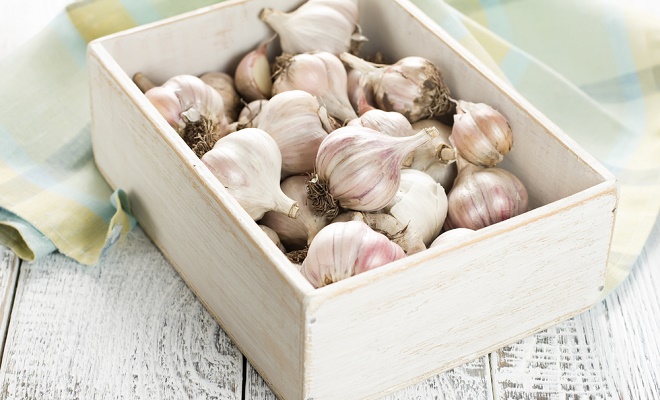
Since the winter (winter) variety is stored worse, they try to use it first. Yarovoy can lie without problems until the very spring
Tip of the day
For storage, select only strong healthy bulbs, preferably large ones. Therefore, try to dispose of small heads damaged during harvesting or infected with diseases and pests immediately or use them as soon as possible.
And now how to store garlic. Choose the most appropriate one, taking into account the features of your storage (house or apartment):
Storing garlic is not difficult at all. Choose in practice the best option and use the result of your labors all year round.
Store properly and be healthy!
Someone keeps it in the toilet, someone considers it a violation of sanitary standards. Here, as they say, to each his own. Perhaps the advice of readers will help you decide - the topic is important and topical.
I live in the Southern Urals, in Chelyabinsk. And he was born in Ukraine.
The technology of growing garlic has been known to me since early childhood. He himself began to do this about 20 years ago, with the acquisition of a summer cottage. I grow garlic from my seeds, in a three-year culture, as recommended in all reference books (it has already acclimatized to local conditions).
When growing garlic in a three-year culture, it is rejuvenated, getting rid of many diseases. I tried to get varietal.
The temptation is great: in the catalog of one large company engaged in the sale of seeds, 125 varieties are listed with the names of the breeders! I called the hotline with a request to indicate where the Naprada variety with a shelf life of 11 months was purchased.
I was told that the ordered goods are sent only cash on delivery, at least three sets at a price of 180-190 rubles. each, 10 cloves in each set. But they did not give me a guarantee that they would send exactly the garlic that was ordered. And I was already taught by the bitter experience of acquiring seedlings of the Symbol apple tree at the local breeding station - three times in five years: the desired variety did not ripen for me.
But back to garlic. So, as I said, I grow garlic in a three-year culture. First, in autumn (in October) - with cloves, single teeth and bulbs in equal quantities. I mulch with chicken humus, so the garlic has never frozen out. In the spring, after germination, I take care as usual. I feed with mullein (1:8) or bird droppings (1:10) with the addition of ash. I dilute the solution for feeding in a large container (about 32 buckets to save time in the future when dosing).
I feed three times a season with an interval of three weeks. After each top dressing I water and loosen. Weeding as needed.
I harvest garlic from July 20 to August 1 - the sooner the better. If the weather is rainy during harvesting, after digging up the garlic, I wash it from dirt in a trough with water and dry it, laying it out on the garden bed, for about a day, letting the water drain. After thorough drying, I weave into braids. In order to save time, I weave lashes, taking three garlics at once in one bunch.
To prevent spontaneous untying of weaving, I tie the ends of the braids with ropes.
After weaving is completed, I lay out the garlic on boards, tables or hang it on bars in the attic of a bathhouse or garden house and leave it to dry until the end of October. Before the threat of frost, at the end of October, I cut off the heads and put them in plastic vegetable boxes, and I put the boxes away either in a garden house or on a glazed veranda in an apartment - I put them in a stack on top of each other.
I cut the garlic roots in half or less.
The main condition is that the garlic dries well before storage, especially the top layer of the husk. If the temperature in the place of storage threatens to drop to minus values, I put it in cardboard boxes from under medicines or shoes.
Depending on the number of heads in the boxes, you can fill the gaps between them with dill seeds (ideal!) or agro-vermiculite.
Dill seeds have bactericidal properties, and agro-vermiculite is kept in ovens at a temperature of 900 °, which also contributes to a good preservation of the crop.
I seal the boxes with garlic packed in them with adhesive tape and place them on the mezzanine in the corridor. For storage, it is advisable to choose the coolest place in the apartment.
In the photo: garlic after storage at the end of April this year. In this way, I kept single teeth on shelves in the basement of the garage, and they did not lose their germination.
Common methods of storing garlic in salt, with burning the roots over a gas stove or a candle, covering the heads with melted paraffin are not suitable because of the complexity, and most importantly, they do not give the desired results.
Ivan Mikhailovich LYCHAK. Chelyabinsk
I dig garlic in dry weather. I never wash it! I clean it from the ground, carefully remove the top dirty layer, then cut off the roots and stem so that I can tie it into bunches. I knit six or seven pieces in a bundle and hang them in the shed to dry. If it's hot outside, I put it out in the sun a few times. When the garlic dries, I cut the stem, leaving only the heads.
Last year there was a lot of garlic, I put the heads in a bucket and put it in the kitchen. My daughter needed fir cones for school for autumn crafts. My husband brought a lot of cones from the forest, some of them were taken by my daughter, and it was a pity to throw out the rest, and I put them on top of the garlic in a bucket. The heads were taken as needed, and the cones were still on top in the bucket. And the garlic kept as well as ever! Clean, strong, as if fresh from the garden!
I read that infusion fir cones treat tonsillitis, sinusitis, pneumonia. So, they contain some antimicrobial substances. Perhaps this is the whole secret. So this bucket is on the kitchen floor. In the fall, I will definitely ask my husband to bring cones again!
In winter and spring, colds are not uncommon. To cope with them, we swallow handfuls of pharmaceutical tablets, pills, powders and other drugs. Meanwhile, most of us have garden plots where medicinal vegetables grow.
And I want to dwell on one thing: this is a universal medicinal plant - garlic. It is a natural antibiotic that copes with various bacteria and is able to defeat any infection.
garlic oil
Garlic is a pantry of vitamins and microelements. With the initial signs of a cold, he can become the first assistant. My grandmother used to cook garlic butter. It is necessary to take 4 heads of garlic, grate, fill a small jar with the resulting slurry and add a third of the vegetable oil (from the mass of garlic). Mix thoroughly, cover and put in a warm place to infuse for two weeks, periodically opening and stirring. After this period, the mixture should be filtered, and the oil is ready.
It is good for sore throat and runny nose. You need to take 1 tsp. garlic oil, diluted in 1 liter of boiled water, mix well and gargle or instill into the nose. After several procedures, the disease will recede. This recipe can also be used for the flu.
Recipe
To cleanse the vessels of cholesterol plaques, take 1 tsp at the same time. garlic oil and freshly squeezed lemon juice. Do this 3 times a day 30 minutes before meals. The duration of the course of treatment is 90 days. After that, a monthly break is taken, and then the course is repeated.
Outwardly
Garlic oil is also used externally. It is rubbed into the scalp for hair loss, increased brittleness and dryness of hair, seborrhea. The oil is applied to problem areas of the skin with allergies, acne, long-term non-healing wounds, abrasions, bruises. With the use of oil, you can make warming compresses for sciatica, neuralgia and inflammation of the joints. This remedy also helps relieve itching from insect bites.
Garlic without oil
But it is quite possible to be treated simply with fresh garlic, without insisting it on oil.
For influenza, grate five cloves of garlic and inhale the vapor for 5 minutes three times a day - morning, afternoon and evening.
With a toothache, peel one clove of garlic from the husk and chew it for 3 minutes, all microorganisms will die in the mouth, and the pain will stop.
To relieve pain in the knees and joints, you need to chop one head of garlic and 200 g of onion. Pour the prepared mass with 1 liter of alcohol and let it brew for two weeks, shaking occasionally (by the way, alcohol can be replaced with vodka). The disturbing joints are rubbed with the finished product.